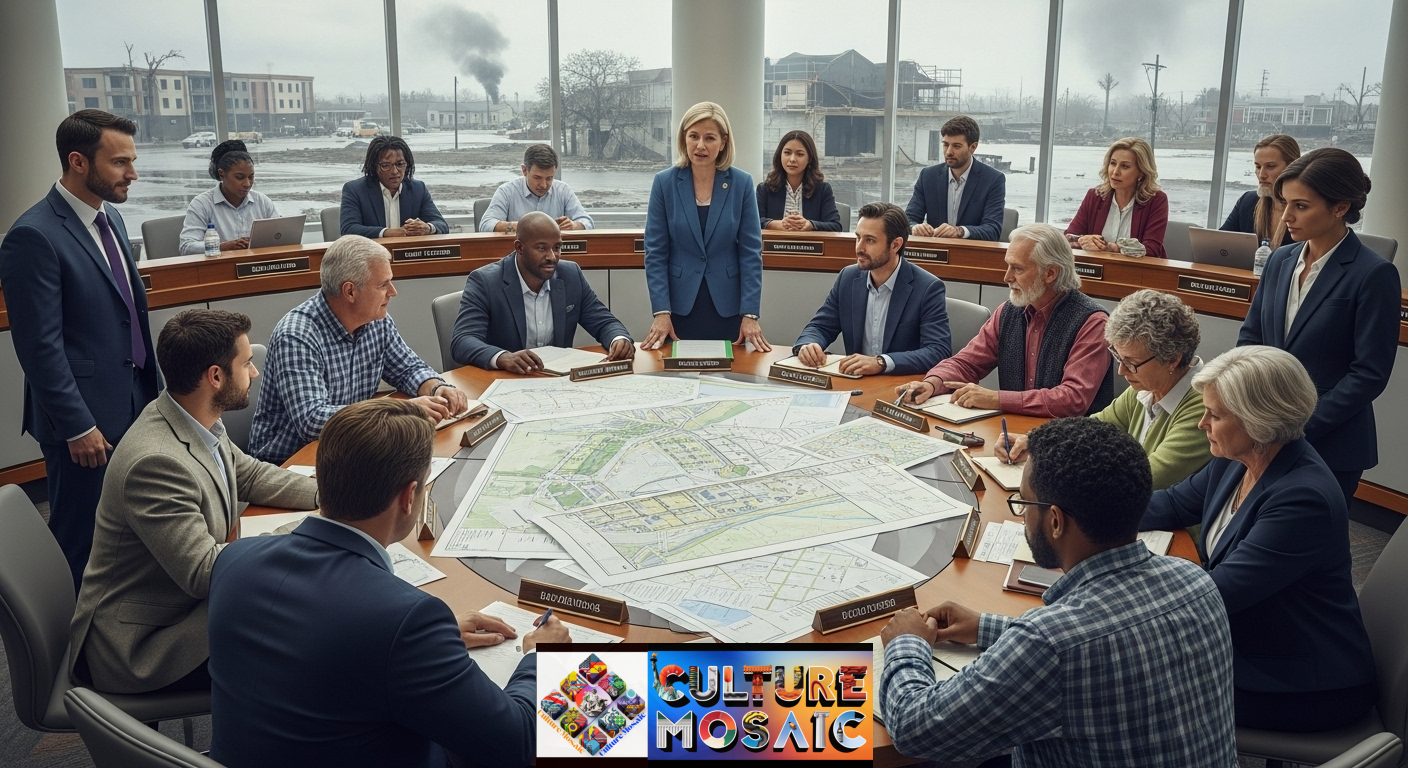“Build Back Better”: In the aftermath of a disaster, the scene is stark: glimpses of floodwater, extinguished fires, and the remnants of tornado debris. But the real challenge begins—not against nature, but concerning the future of your community. When disaster strikes, the phrase “build better” shifts from a political slogan to an urgent question: for whom are we building better? Who decides what gets rebuilt, where it will be located, and how it will be constructed? Most importantly, when these decisions are made, do you have a seat at the table?
In the North, local power, citizen engagement, and moments of crisis can either reveal a united community or expose uncomfortable truths about existing fractures. While federal disaster relief can provide funding, it is your local Zoning Board, City Council, and Planning Commission that determine whether your neighborhood thrives or fades away.
Build Back Better Starts in City Council Chambers, Not Washington
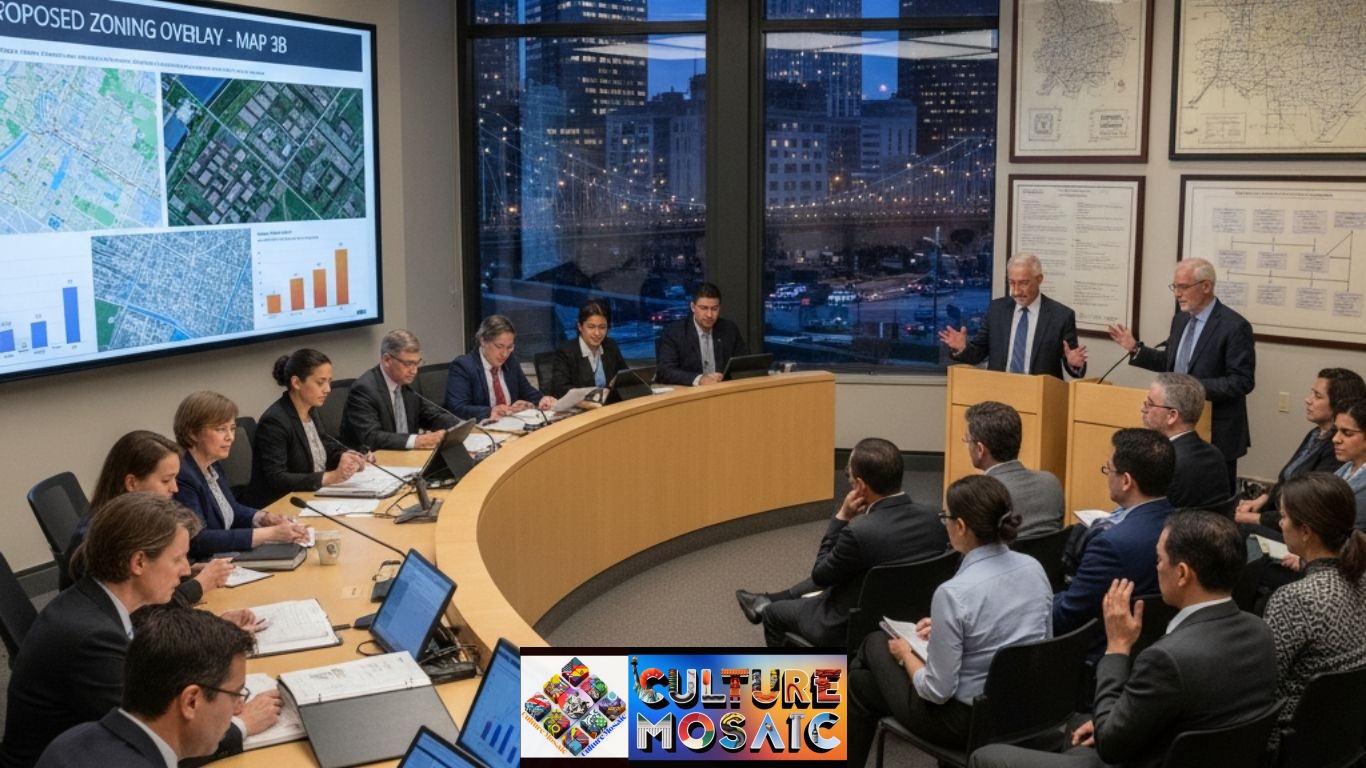
Build Back Better: When federal disaster declarations unlock millions in relief funding, that money doesn’t arrive with a detailed blueprint. Instead, it flows through local government structures where decisions happen in zoning board meetings, city council sessions, and planning commission hearings—forums most residents have never attended.
These aren’t ceremonial proceedings. They’re where actual power gets exercised. A zoning variance approved or denied determines whether a small business can reopen in its original location. A comprehensive plan amendment decides whether your residential street becomes a commercial corridor. A floodplain ordinance revision may prohibit rebuilding your home on its original foundation.
The participants in these meetings—often just a dozen residents plus officials—make choices affecting thousands. If you’re not in the room, someone else is deciding your community’s future without your input.
The Federal-to-Local Pipeline: How FEMA and HUD Money Reaches Your Town
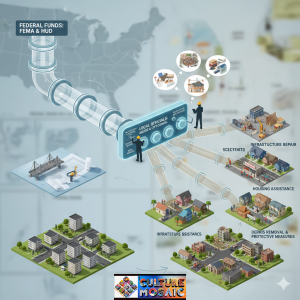
The Federal Emergency Management Agency (FEMA) and the Department of Housing and Urban Development (HUD) have a complex process for providing disaster assistance to your community. FEMA’s public aid program reimburses local governments for expenses related to debris removal, emergency protective measures, and infrastructure repair. Meanwhile, HUD’s Community Development Block Grant Disaster Recovery (CDBG-DR) program offers flexible funding for long-term reconstruction efforts.
Build Back Better: The key point to understand is that local officials have the authority to decide how to allocate these funds within the framework set by federal guidelines. Your mayor and city council determine whether the money will be used for residential reconstruction, restoration of commercial districts, or upgrading infrastructure. They also decide which neighborhood procurement offers to accept and who will carry out the rebuilding efforts. Additionally, they determine which projects qualify as “Economic Development” versus “Housing Assistance.”
These decisions include real discretion, not automated formulas. Two cities receiving uniform federal allocation can create fundamentally different options -and fundamentally can produce different results.
Build Back Better or Build Back Differently: The Zoning Board’s Power
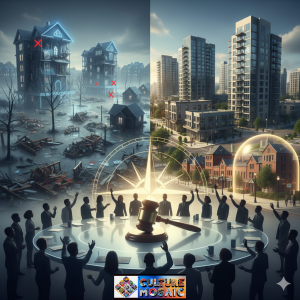
Build Back Better: Zoning board decisions become essential for community changes after a disaster. A disaster often presents a unique opportunity—sometimes the only one in decades—to revise zoning codes, update comprehensive plans, and re-establish community structures. Whether these changes lead to real improvements or simply benefit developers depends entirely on the level of civic engagement.
Consider what is at stake: A zoning board has the power to change residential areas into mixed-use zones, permitting commercial development in places where only homes existed before. They can increase the allowance for density, which could lead to the construction of apartment buildings in family-oriented neighborhoods in the east. Additionally, they can create historical conservation districts that restrict reconstruction options or choose to remove such protections to promote rapid growth.
Property owners may find themselves in a difficult situation as they are not guaranteed the right to reconstruct their properties. Floodplain remapping can prevent rebuilding on the same footprint, and new height requirements could make reconstruction financially unfeasible. Additionally, zoning changes made during the crisis period can fundamentally alter what you are allowed to do with your property.
Build Back Better Through Community-Led Planning Committees
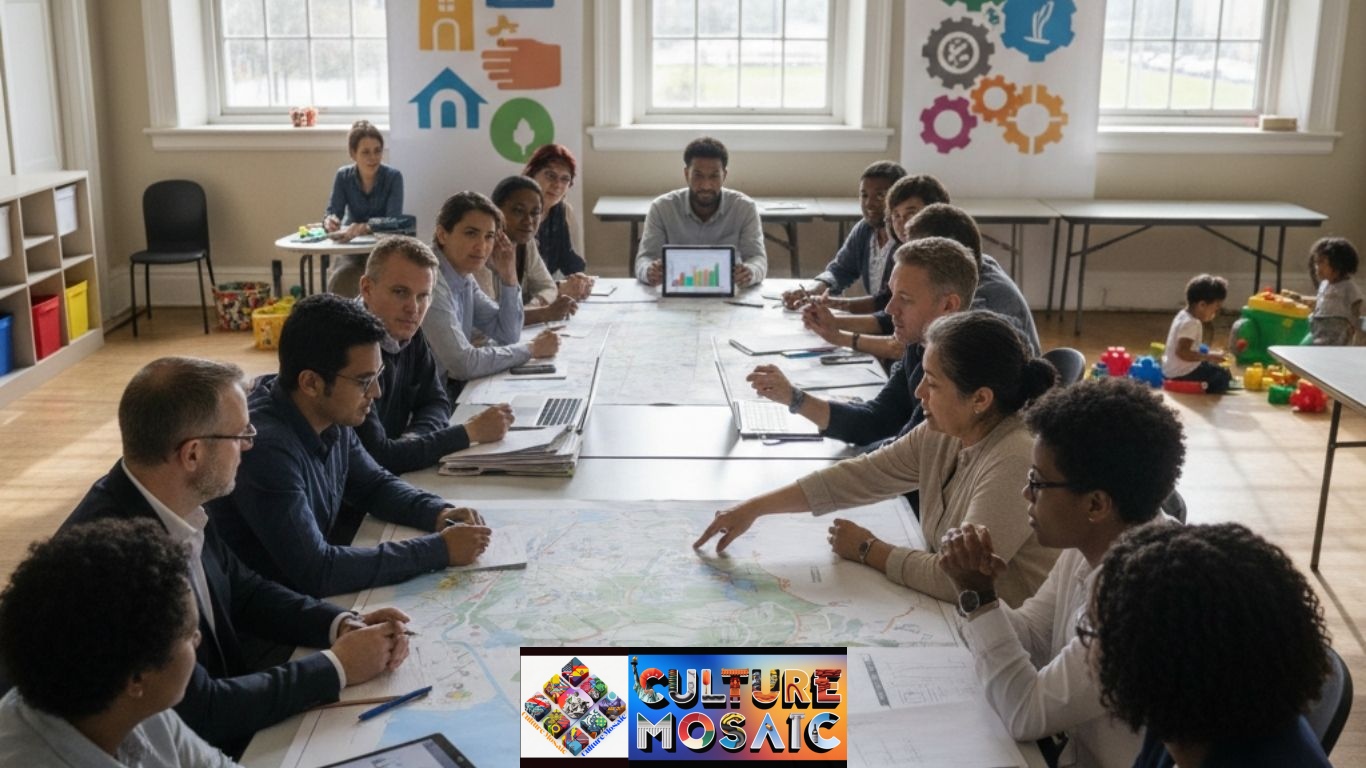
The most effective recovery after an event occurs when community-led planning committees involve residents in prioritizing reconstruction efforts. When these committees are well-structured, they connect government officials with affected residents. This ensures that recovery plans are aligned with the actual needs of the community, rather than relying on abstract planning principles.
Effective community planning committees are characterized by diverse representation, including homeowners and tenants, business owners and employees, long-term residents and newcomers, as well as individuals from various neighborhoods and economic backgrounds. These committees hold meetings in easily accessible locations at convenient times, offer translation services, and actively encourage participation from underrepresented groups.
But the challenge here is: These committees have only the power that the local government grants to them. Some work as real decision-making bodies with budget authority and plan control. Others act as advisory groups whose recommendations may be ignored. Understanding what types exist in your community – and fighting for the east if you have a latter – essential civil work becomes.
The Civic Fight Over Resource Allocation: Who Gets Help First?
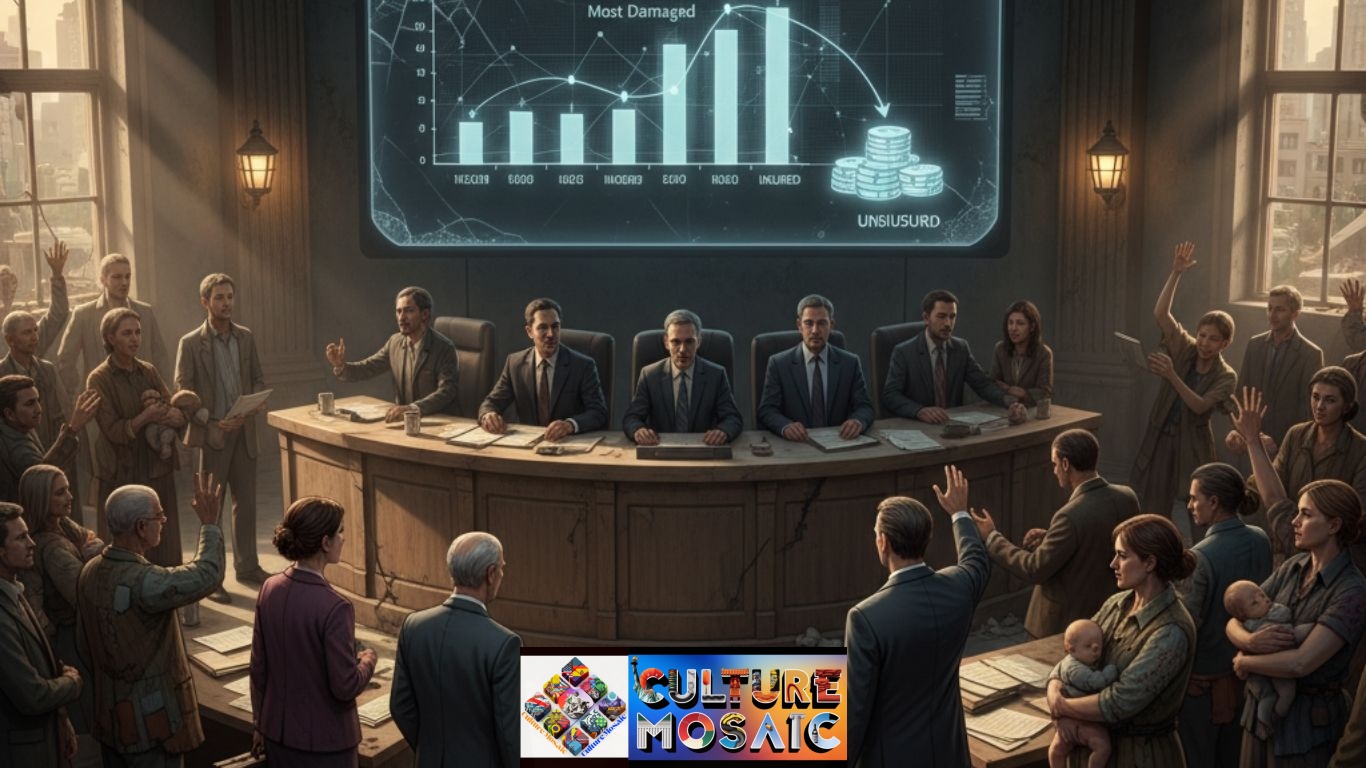
Perhaps no post-Apada Question Resource allocation creates more conflict than priority. Should limited reconstruction funds focus on the most damaged areas, or spread to all affected neighborhoods? Prefer residential or commercial recovery? Help home owners or tenants? Help those people with insurance or without them?
Local officials who make these decisions face an impossible task. Each dollar spent on one priority means that the dollar is unavailable for another. Priority to every neighborhood means waiting for one more. These are not objective with technical decisions with correct answers – they make price decisions about community priorities, and they are in city council meetings where most voices often prevail.
Rich neighborhood usually conducts fast, hire lawyers, and hold public meetings. Low-income areas, where residents work multiple jobs and lack the flexibility to participate in evening meetings, struggle to advocate effectively. Without deliberate efforts to incorporate all voices, resource allocation decisions reflect power dynamics, not real needs.
Build Back Better Infrastructure: The Hidden Opportunity
Disaster recovery presents a unique opportunity to enhance the infrastructure that communities have maintained for decades. Federal relief programs allow for the reconstruction of infrastructure to modern standards, rather than simply replacing what was there before. Is the aging water system in need of repair? Rebuild it properly. What about those outdated electric grids? Use federal funding to upgrade them.
To seize opportunities in this situation, it’s essential to have a well-developed local plan and actively seek federal grants. Communities need officials who understand that FEMA’s “better projects” provisions allow for enhanced reconstruction efforts aimed at improving disaster resilience. Additionally, it’s crucial to have staff who can effectively navigate the Community Development Block Grant Disaster Recovery (CDBG-DR) requirements established by HUD to secure funding for significant infrastructure upgrades.
Small cities with limited administrative capacity often miss out on federal funds because they lack the expertise to pursue available grants. As a result, they tend to rebuild in the same way they did before, missing the opportunity for meaningful improvement. This lack of administrative capacity—though not always glamorous—plays a crucial role in determining whether disasters serve as a catalyst for progress or simply highlight existing shortcomings.
Build Back Better Housing or Build Back Gentrification?
The post-reconstruction phase following a disaster often leads to a significant increase in housing costs. Factors such as rising construction expenses, higher insurance rates, and new building code requirements make affordable housing more difficult to attain. Additionally, the reconstruction process can attract outside investors and new residents seeking to “revitalize” communities, which further intensifies gentrification pressures.
Local governments should actively address these issues to prevent long-term residents from being displaced by redevelopment. This requires implementing several key policies: inclusive zoning to ensure affordable units are included in new developments, strengthening support for land trusts, safeguarding tenant rights to prevent displacement, and providing direct assistance for vulnerable housing.
These interventions do not occur automatically. They require organized residents to ensure that “building better” means improvement for existing community members, not just for developers and newcomers who can afford the reconstruction.
The Role of Public Meetings: Where Democracy Meets Disaster
Public meetings become primary site where general residents can affect recovery decisions. City councils hear comprehensive planning amendments. The zoning board reviews the variance requests. Planning Commissions approved site plans. Each meeting provides opportunities for public comments – usually three to five minutes where residents can support, protest or modify proposals.
These comments matters more than you expect. Officers who make difficult decisions in terrible circumstances actually listen to the component input. They understand that their political promises depend on recovery. A pack meeting sending an integrated message may change the result, while empty chambers indicate that authorities can work without public accountability.
Yet most of the residents have never participated in these meetings and do not know that they are happening. They are usually declared in newspapers, some people read, posted on government websites, rarely visited, and is several times uncomfortable for working families. To overcome these obstacles, deliberate community events and mutual support are required – neighbors helping neighbors participate in democracy.
Build Back Better Requires Building Civic Capacity
Community investing successfully in civil capacity before, during, and after disasters. They have active neighborhoods that can quickly gather. He has created confidence between the residents and the officials through the ongoing engagement. They have established a communication network that works when the common infrastructure fails.
This citizen infrastructure is not in crisis – it already exists, or it does not exist at all. The time to make a relationship with your city council is before the disaster strikes, not later. The time to understand the structure of your local government is during normal times, not during chaos.
Communities with this foundation deficiency have to struggle to respond effectively. Residents do not know who to contact for help. Officers are not aware of community priorities. The lack of trust generates conflict. The reconstruction slows down, becomes more controversial, and less justified. To improve the building, first, civic capacity is built.
Federal Guidelines, Local Discretion: Understanding the Balance
Build Back Better: The federal disaster program comes with requirements. FEMA demands that the reconstruction of the infrastructure meet the current code and standards. HUD requires environmental reviews, fair housing compliance, and procurement rules. These rules exist for good reasons- quality construction, preventing discrimination, and protecting the taxpayer dollar.
But within these railings, local officials maintain heavy discretion. They decide which alternative programs to advance, how to prioritize competitive needs, and how to explain flexible guidelines. You can make different choices about two communities with uniform federal money:
What is the use of aggressive or minimum purchase programs? How much to invest in commercial vs. residential recovery? Should preference to the speed of reconstruction or prioritize community input processes? How to balance personal property rights against community flexibility goals.
Understanding this conscience helps the residents to know where to focus the advocacy. Some decisions are federally compulsory and irreversible. Other local options are where community pressure may transfer results.
Build Back Better Participation: Making Your Voice Heard
Build Back Better: Effective participation in post-disaster recovery requires a strategy. Just participating in meetings and speaking during public comments, while important, is not enough. Consider these approaches:
Arrange with neighbors before meetings to present integrated positions. Individual voices are exempted as an outlier; Twenty residents attracted the same thing. In addition to oral testimony, submit written comments, ensuring that your situation is documented in the official record. Instead of waiting for relevant objects to appear, request the specific meeting agenda items to discuss special concerns.
Make a relationship with the local media to increase community concerns. A three-minute public comment reaches the authorities; A newspaper article reaches thousands of people. Participate in every meeting, even when your issue is not on the agenda, as it shows continuous engagement rather than one-time interest.
Consider whether advocacy alone would be enough, or if you need to run for the office yourself. Zoning boards, planning commissions, and city councils require members who understand both community needs and complex recovery processes. Your experience of navigating disaster can help you meet the needs of your community properly.
Build Back Better for Whom: The Equity Challenge
Build Back Better: Each community declares the intention of “better construction” after a disaster. Existing residents vs. for the future people, for the future people, for poor neighborhoods vs. Equity Challenge runs in full recovery:
Homeowners typically receive FEMA assistance, but tenants usually do not. Business owners can access SBA disaster loans, while employees often lose their jobs without any comparable support. Insured property owners receive compensation for claims, but unlicensed properties receive very little assistance. These disparities persist throughout every phase of recovery.
Local governments can address these inequalities through various policy options. Allocating Community Development Block Grant Disaster Recovery (CDBG-DR) funds can assist displaced tenants with fare assistance. Establishing grants and loans for small businesses enables entrepreneurs to access funding without incurring debt. Additionally, creating retraining programs for displaced workers can help them find new employment opportunities. However, these interventions require active demand from residents; authorities should not wait for requests to take action.
The fundamental question in post-disaster recovery is whether “better” means better for everyone, or whether it benefits some at the expense of others. How your community answers this question will determine whether recovery brings unity or division.
Taking Action: Your Disaster Recovery Civic Checklist
Build Back Better: You do not need to wait for a disaster to prepare for civic engagement in recovery. Now start:
Identify the members of your local zoning board, planning commission, and city council. Understand their roles and meeting schedules. To gain insight into how they operate, attend at least one meeting for each group. Consider joining or creating a local organization to raise awareness more quickly. Build relationships with your neighbors so that you can organize effectively if needed.
Familiarize yourself with the comprehensive plan and zoning code of your community. These documents outline where specific activities are permitted and whether any changes require approval. It’s also important to understand the administrative structure of your local government—who makes the decisions and how those decisions are made. Additionally, identify community organizations that focus on housing, development, and equity issues, as they will be valuable partners in the aftermath of a disaster.
If a disaster strikes, immediately engage in the recovery processes. Attend the initial community meetings where the framework for recovery is established. Submit public comments on the draft recovery plan. Volunteer for community planning committees and track how federal funds are being allocated and spent. Hold officials accountable for the commitments they have made.
FAQs About Build Back Better
How can I find out when my local zoning board or city council is meeting to discuss disaster recovery?
Check your local government’s official website for meeting calendars and agendas. Most jurisdictions are legally required to post meeting notices at least 48-72 hours in advance. Sign up for email notifications if available. Contact your city clerk’s office directly and ask to be added to distribution lists for meeting notices. Follow local news outlets and community Facebook groups where meeting information is often shared. After a disaster, recovery-related meetings should be prominently advertised, but don’t rely on that—proactively seek information.
What rights do I have to participate in public meetings about rebuilding my community?
Most local government meetings must allow public comment periods under state open meetings laws. You have the right to attend, observe, and typically speak for a designated time (usually 3-5 minutes). You can submit written comments that become part of the official record. However, officials aren’t required to follow public input—they must allow it, not obey it. Understanding this distinction helps you recognize that participation is necessary but not sufficient; you need to persuade officials, not just inform them of your position.
How do I know if my property is affected by new floodplain maps or zoning changes after a disaster?
Contact your local planning or building department to request current zoning and floodplain information for your address. FEMA updates Flood Insurance Rate Maps (FIRMs) after major disasters, and your community may adopt new floodplain ordinances. Your property’s flood zone designation affects rebuilding requirements and insurance costs. For zoning, review meeting minutes from your city council and planning commission since the disaster—zoning changes require public hearings with notice to affected property owners, but you may miss notices if you’re displaced.
What’s the difference between FEMA assistance and HUD disaster recovery funding?
FEMA provides immediate disaster relief through its Individual Assistance program (helping households with temporary housing, home repairs, and other needs) and Public Assistance program (reimbursing governments and nonprofits for debris removal, emergency services, and infrastructure repair). This assistance focuses on short-term recovery. HUD’s Community Development Block Grant Disaster Recovery (CDBG-DR) program provides longer-term flexible funding to local governments for housing, infrastructure, and economic revitalization. FEMA gets deployed immediately; HUD funding arrives months or years later but addresses unmet needs FEMA couldn’t cover.
Can local officials use disaster recovery as an excuse to change my neighborhood without proper community input?
While disasters create opportunities for rapid policy changes, most significant decisions still require normal public processes—hearings, notices, comment periods. However, some jurisdictions do suspend or expedite usual procedures during declared emergencies. This makes early engagement critical: attend initial recovery planning meetings, demand that emergency procedures include public input, and insist that major policy changes follow standard procedures even if that slows recovery slightly. If officials bypass required procedures, you can potentially challenge decisions through administrative appeals or, in extreme cases, litigation. Document everything and consult with local advocacy organizations or attorneys if you suspect procedural violations.
Conclusion: Build Back Better
“Build back better” is not a passive phrase that simply refers to improvement following a disaster. Instead, it represents an active challenge that necessitates civil engagement, organized advocacy, and often arduous government processes. The quality of your reconstruction community will largely depend on this effort, as it primarily shapes the outcome.
The inconvenient truth is that disasters create disparities in recovery, resulting in winners and losers. These outcomes are not random; they reflect the dynamics of power, community resilience, and organized advocacy. Communities that recover effectively do not achieve this by chance. Their recovery happens because residents demanded it, engaged in advocacy efforts, and actively participated in every meeting, hearing, and decision-making process that influenced the recovery efforts.
Your seat at the table is not guaranteed. You must claim it, defend it, and use it effectively. The question is not whether your city will rebuild, but rather whether you will influence how that reconstruction takes place. The answer depends on the choices you make now—before a disaster strikes, not afterward.
Start participating in meetings. Relationship construction. Learn the procedures. Develop civil capacity. When the disaster comes, you will be ready to fight for the future of your community, wondering why no one asked your opinion, while strangers rebuilt your city.You don’t have to wait for a disaster to prepare for civic engagement in recovery. Start now.

